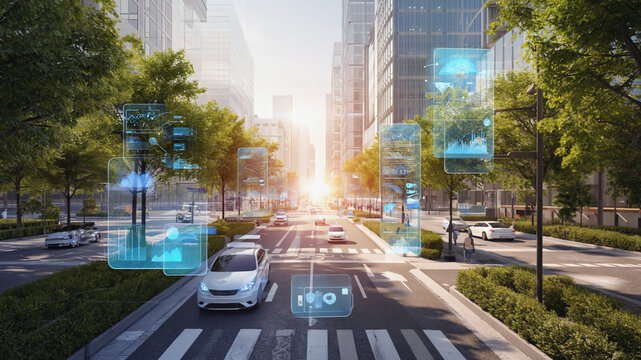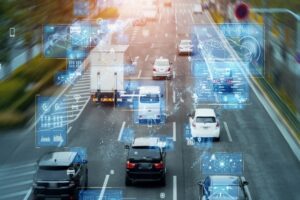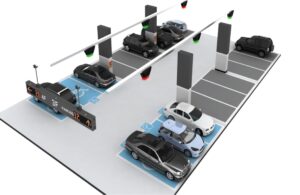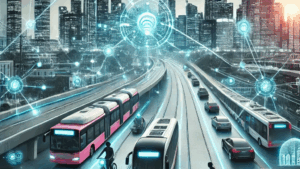Cities around the world are changing the way people get around. Smart mobility is a new mindset that leverages technology, data, and new mobility options to make cities more livable. This comprehensive system encompasses everything from electric buses and bike-sharing programs to ride-sharing apps and intelligent traffic management systems. By integrating these technologies, cities can address long-standing problems like congestion, air pollution, and mobility restrictions. Furthermore, cities can improve the sustainability and efficiency of transportation networks and better serve their residents.
Understanding Smart Mobility
Smart mobility means leveraging digital technologies and data-driven solutions to make urban transportation systems more efficient. Today, communities are transitioning from traditional ways to using connected cars, real-time traffic monitoring, and interconnected public transportation systems. This approach is transforming the way people navigate cities by offering various transportation options that work together. Smartphone apps allow people to view real-time bus schedules, find available parking, or locate nearby bike-sharing stations. Combined with artificial intelligence and IoT devices, you have a transportation system that adapts to the weather and user needs throughout the day.
The Benefits of Smart Mobility
The benefits of smart mobility systems go far beyond simply improving transportation. Cities implementing these technologies report improved quality of life for residents, lower infrastructure costs, and better resource utilization. People gain access to more reliable and convenient transportation, while city planners gain valuable insights that help them make informed decisions about future spending. Smart mobility solutions are flexible, allowing communities to quickly adapt services to the needs of population movements, special events, or emergencies. These systems also make transportation more equitable, allowing everyone to fully enjoy city life, regardless of their financial means or mobility options.
Improving the Use of Transportation
One of the greatest impacts of smart mobility is that it makes urban transportation more efficient. Intelligent traffic management systems use real-time data to adjust traffic light hours, reducing wait times and fuel consumption. GPS tracking and predictive analytics help public transportation networks adjust schedules in real time to reflect actual demand trends. Car-sharing services reduce the number of private cars on the road by allowing more people to efficiently share resources. These efficiency gains mean shorter travel times, less travel stress, and more efficient use of existing transportation infrastructure. Cities can accommodate more people without building more roads or expanding parking spaces.
Environmental Impact
One of the most significant benefits of smart mobility in cities is the environmental impact. Compared to diesel buses, electric and hybrid vehicles in public transportation can significantly reduce greenhouse gas emissions. Bike-sharing programs and pedestrian-friendly infrastructure encourage people to use low-emission transportation for short trips. Intelligent transportation systems reduce wait times at intersections, reducing fuel consumption and air pollution. Because people use shared cars instead of private cars, both car production and the demand for parking spaces decrease. This helps mitigate the urban heat island effect. These environmental changes lead to cleaner air and a more livable urban environment.
Economic Growth and Jobs
Cities and their residents have reaped significant economic benefits from investments in smart mobility. As cities seek new mobility options, the IT sector is booming, creating jobs in software development, data analysis, and systems maintenance. More efficient transportation reduces logistics costs for companies, making cities more attractive to businesses looking to move. Workers are also more productive because they spend less time stuck in traffic. The sharing economy of smart mobility offers people new ways to earn money, such as offering car-sharing or delivery services. Cities can also redirect money spent on roads and parking to other societal needs, such as education, healthcare, or green spaces.
Smart Mobility and Safety
Another key benefit of smart urban mobility systems is improved safety. Connected vehicle technology can warn drivers of potential hazards in real time, helping to prevent accidents. Smart traffic lights and crosswalks use sensors to monitor pedestrian flow and adjust timing as needed, reducing vehicle-pedestrian conflicts. Emergency communication systems and real-time monitoring systems for public transportation improve passenger safety. Cities can use data analytics to identify intersections prone to accidents and poor road conditions, enabling targeted safety improvements. By connecting emergency response systems to transportation networks, the response to medical emergencies or natural disasters can be accelerated.
Smart Mobility Transforms Urban Lifestyles
Smart mobility is more than just a technological advancement; it fundamentally changes how cities function and how people live. By building interconnected, efficient, and environmentally friendly transportation systems, cities can simultaneously address multiple problems and improve everyone’s lives. For smart mobility to succeed, continued investment in technological infrastructure, fostering public-private partnerships, and encouraging active participation in new transportation options are necessary. As more cities embrace these solutions, we can expect further refinements in urban transportation systems and the emergence of new ideas. This will make cities more livable and sustainable, creating stronger economies for future generations.
FAQs
1. Could you please explain what smart mobility is?
Smart mobility refers to the use of digital technologies, data analytics, and connected devices to improve the functioning of urban transportation systems. This encompasses a wide range of applications, from intelligent traffic management systems to car-sharing apps.
2. How does smart mobility alleviate traffic congestion?
Smart mobility reduces traffic congestion by optimizing traffic conditions in real time, encouraging car-sharing to reduce the number of vehicles on the road, and creating integrated public transportation systems that offer better alternatives to driving alone.
3. Is smart mobility beneficial for the environment?
Yes, smart mobility has a significant environmental impact because it utilizes electric vehicles, finds optimal routes to save fuel, and encourages carpooling, thereby reducing overall vehicle emissions.
4. What are the costs of implementing smart mobility?
In the long run, cities generally save money by investing less in infrastructure maintenance, operating more efficiently, and achieving faster economic growth.
5. How does smart mobility create a safer environment for people who live there?
Smart mobility makes transportation safer by using connected vehicle technology to prevent accidents, intelligent transportation systems to ensure pedestrian safety, real-time monitoring of public transportation, and data-driven methods to identify safety risks.




